In a world that is increasingly digitalized and automated, everything that works analogue has become an oddity. Take something as simple as a thermometer. I literally know nobody at all who owns and uses a thermometer anymore. Not a single person! Instead, you check Google how warm or cold it is, or will be during the day. Digital gadgets are so much faster! And also, they are so much more convenient. Because these combine many data and process them into perfect interpretations. No need for you to think about it anymore. In this, it´s also much more practical. Again, take the thermometer: To know how warm it is outside now at this moment is one thing. It´s just very limited information. But one click online gets you a detailed weather forecast how the day would be like in your town including weather radar for precipitation, the wind chill factor and even pollen count. Who needs a thermometer anymore? This is, why I went to Hamburg last week.
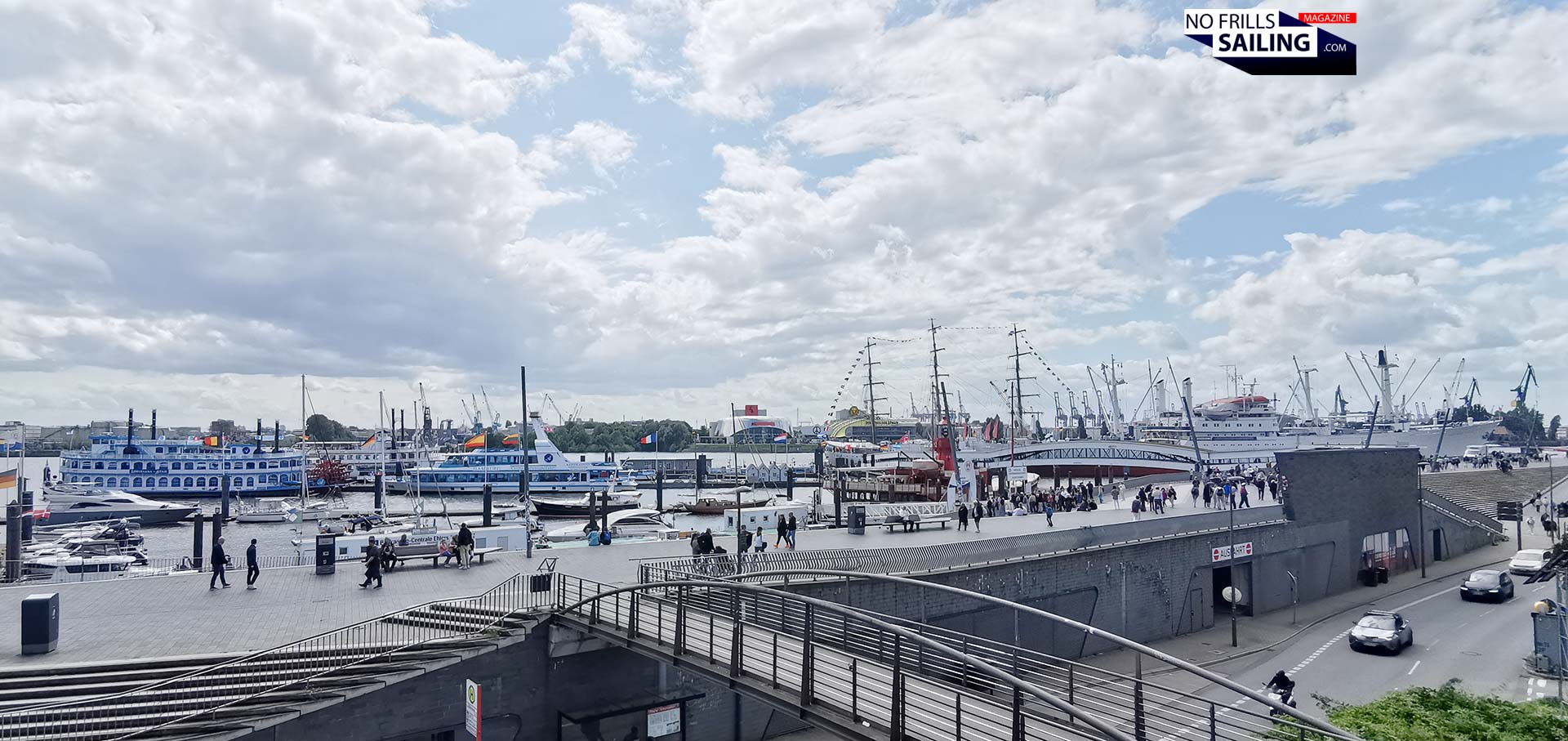
Why? Because here is the HQ of Wempe, one of the last manufacturers of classic marine instruments for yachts – and one of the very few prime clockmakers for professional timekeeping systems aboard big ships, like freighters, cruise ships and even navy vessels. I went here to collect the marine instruments for ALPHA. You know that I love to go where the stuff is made that I buy. As Hamburg is just an hour drive away from my home, that´s a no brainer. I was happy that Julius Kaiser, Sales Manager for Wempe Maritime Instruments welcomed me at the awe-inspiring entrance of their newly renovated, impressive and beautiful classic office building, just a stone throw away from Hamburg harbor. My intention was not only to grab the brand new ship´s clock and barometer for my yacht, but to dive deeper into the question: Do we really need those instruments aboard a sailboat nowadays?

Well, of course: Weather forecast, and its interpretation, is an art any skipper should become a master of. Today, at least for the majority of sailors I know, it is mostly the look onto apps like Windy or Windfinder, combined with some weather radar checks for your locality or region. That´s it. Almost nobody checks for the “whole picture”, like the big weather systems, their regional and local implications. Nobody looks at barometric weather charts – let alone draws their own conclusions. Which is sad and good at once: Weather predictions are pretty accurate nowadays, at least for the coming 24 to 35 hours in your region. Local predictions? It depends, mostly not so much. The big picture? Is it still needed for the ordinary skippers? Well. It´s a big topic. My point is this: Which barometer should I go for to be fitted to my boat´s salon?
Nice, but largely useless, decoration? About classic analogue marine instruments.
Do you have the “classic pack of three” in your boat´s salon? A sailboat´s saloon isn´t really cozy until there´s a barometer, a hygrometer and a ship´s clock, right? At least that is what many skippers still think. Including myself. Looking at the iconic Omega 42 by Peter Norlin, it doesn´t even take me a second to think about it: Of course does the boat need these instruments! But here´s the thing: Apart from color, design and personal taste – which product to choose? The range of available instruments is large: There´s the lower priced stuff, starting at some 90 Euros and some high priced upper shelf offers reaching staggering 1.600 Euros. There are a handful of more or less renown brands, like Barigo, Fischer or Plastimo – and many “no name”-manufacturers offering products in marine style.
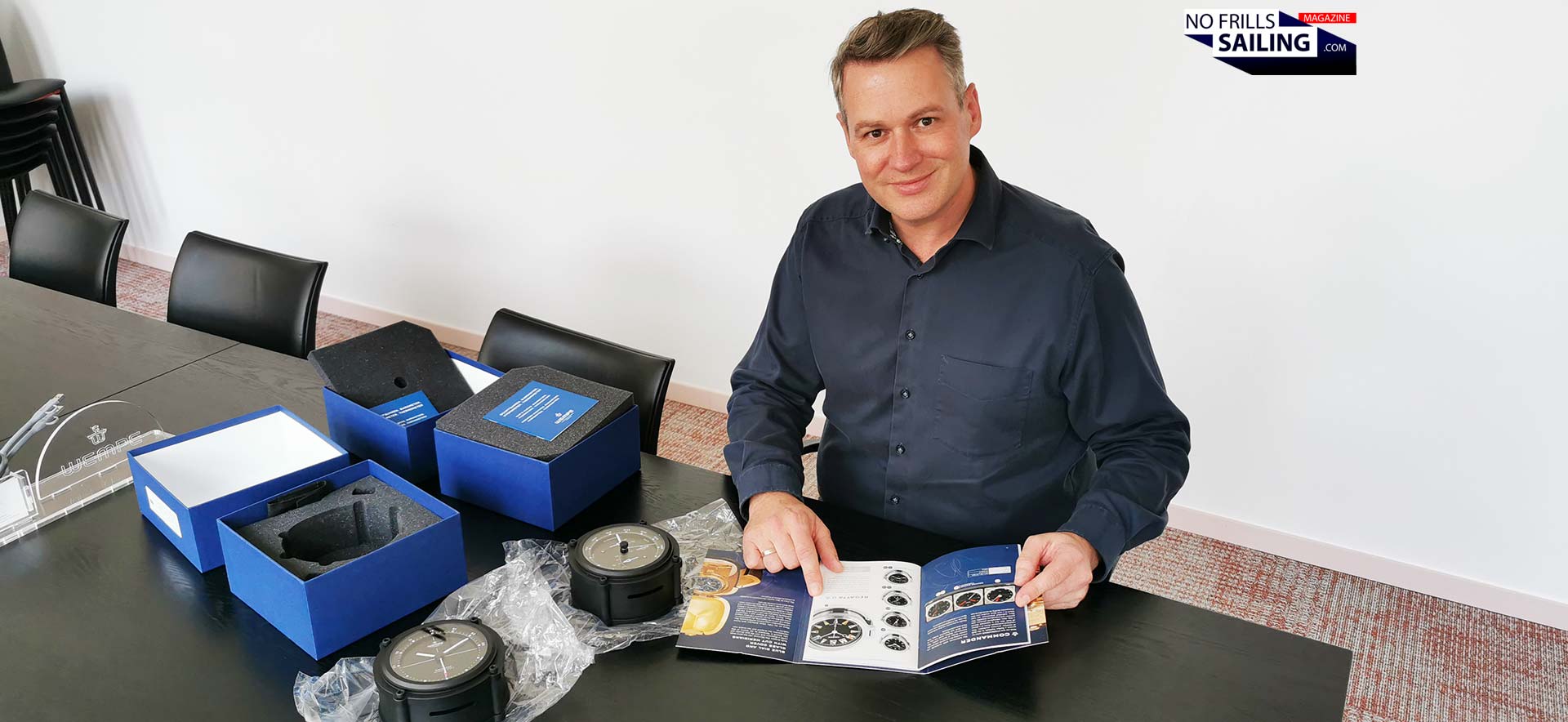
I´ve returned to Julius and with him, to one of the world´s most renowned companies for ship´s clocks and chronometers and instruments for weather observation, because I have a kind of connection to them. My first ever yacht, a 45 years old King´s Cruiser 33 already came with some Wempe instruments. This is when I first met Julius. At that time asking if those old instruments could be refurbished (which indeed was possible). Today I am here not only to collect the products for my brand new boat, but also to tap into his wide knowledge. I want to tackle the following questions: Are these instruments really useful and valid in our digitalized and wired world? What is the difference between a cheap and an expensive marine instrument? How (and where) are they installed best and utilized by a skilled skipper. Or, in other words: Are classic analogue marine instruments still valid?
The difference between a ship´s clock and a chronometer
I am happy Julius took off some of his precious time to not only give me a crash course in these matters, but also to show me around in Wempe´s brand new clockmaking workshop. Strange, at first, because we last met almost 10 years ago. A happy occasion (and a bit scary, seeing us becoming so grey). At first, let´s start with the ship´s clock. It is not the same, Julius insists. Many people, including myself I must admit, use this term wrongly. We proceed to a chronometer and Julius shows it to me. It´s a wonderful piece of art and craftmanship – made to adhere to the highest standards for precision. To make and sell real chronometers, manufacturers have to be incredibly accurate: Something, not many can still do. Wempe may be the last company making those tools.
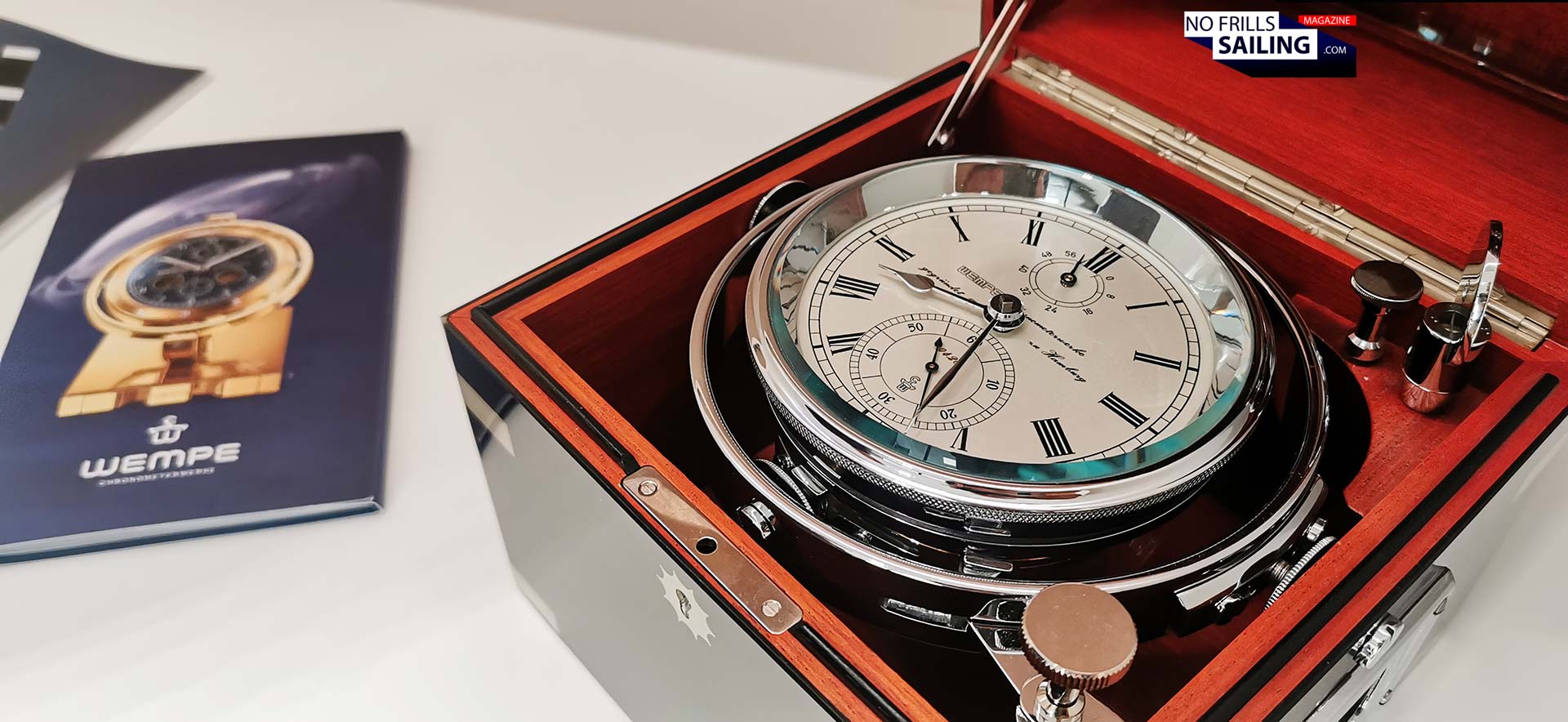
A chronometer is extremely accurate because even a few seconds off will multiply into dozens of miles deviation from your ship´s position. Well, everybody uses GPS now, almost nobody masters the art of stellar navigation, you may think. An that is true: The advent of electronic navigation was the reason for the fact that Wempe solely remains as the prime manufacturer for such accurate chronometers. But it is changing, as Julius tells me: With GPS-spoofing, electronic warfare and a growing meddling with satellites, even the mighty US Navy increasingly re-instated the training of their sailors in celestial navigation. The need for these instruments increases, worldwide.
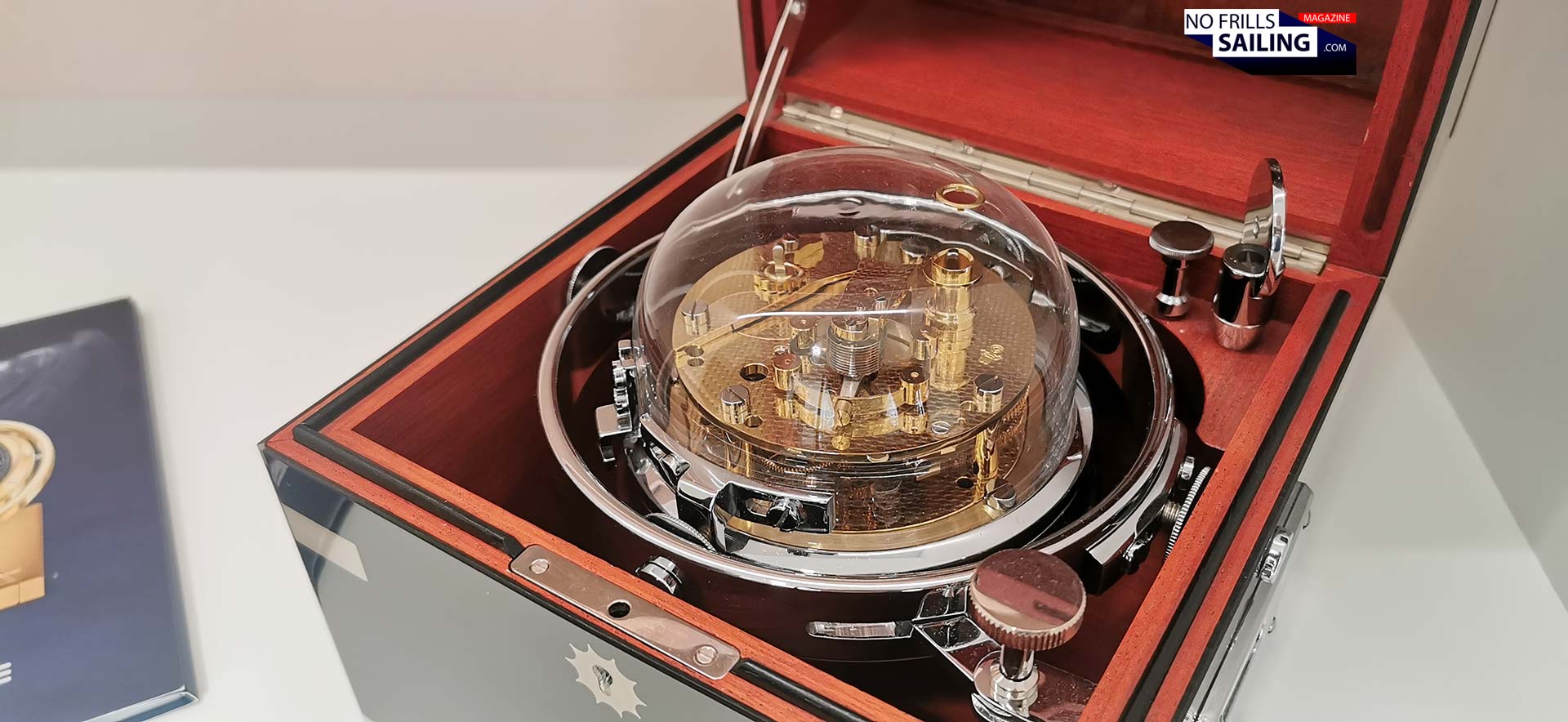
On the other hand, Julius tells me by flipping the chronometer´s face and exposing it´s beautiful, intricate interior workings, many people just love to have one of these. For pure decorative reasons. Many privately owned chronometers aren´t actually used in yachts. They are gracing desktops or offices and bring a maritime flair to any room. But they still have real sailors as clients, Julius tells me: Die hard sailors who want the “full real” experience aboard, but also participants for the Golden Globe Race for example, where everything digital is not allowed. So what does “incredibly accurate” in terms of chronometers and “ordinary” clocks mean in reality? We sit down in Wempe´s meeting room, Julius opens the wonderful packages which contain the instruments for my boat and points to the ship´s clock I´ve ordered:
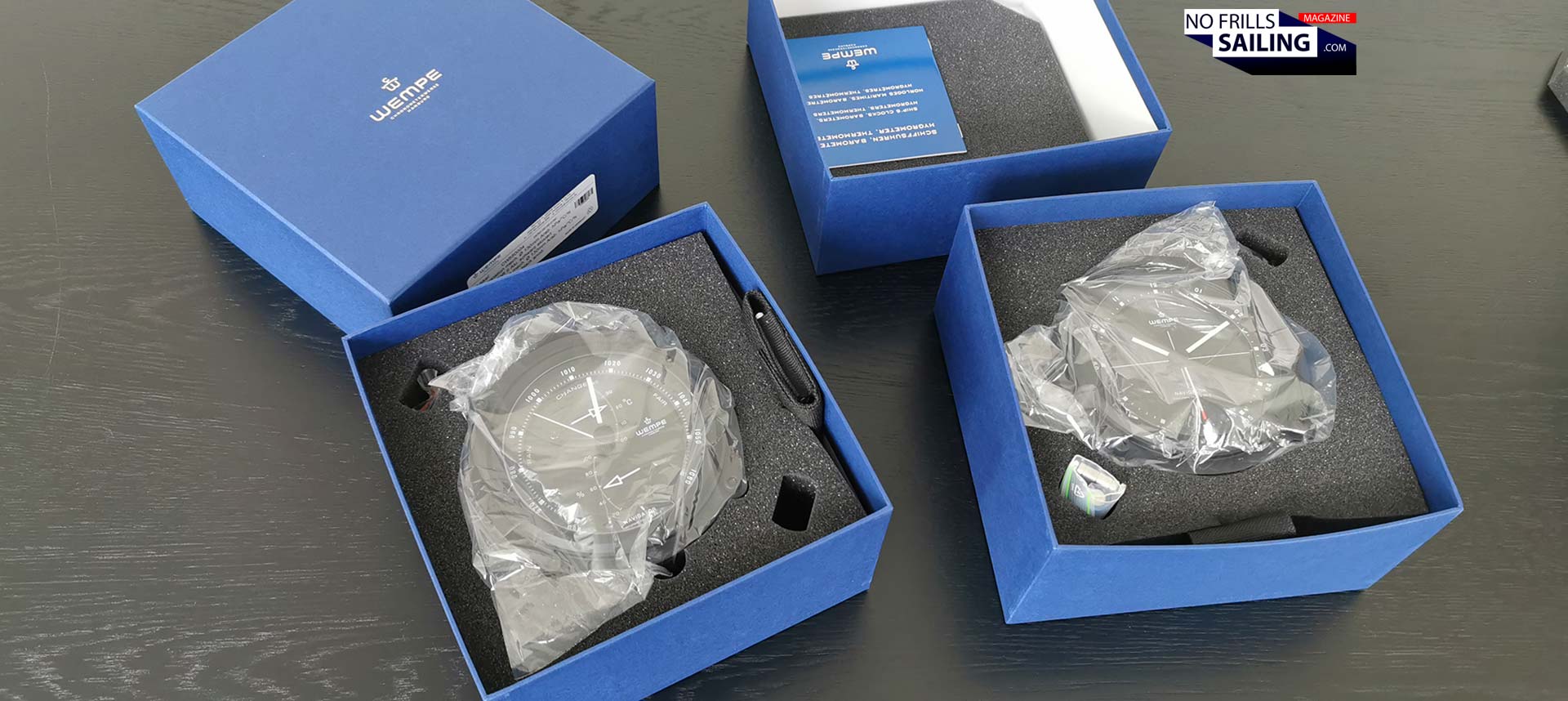
“You decided to go for our “Navigator II”-series instruments, Lars”, he starts: “That´s a great choice! The rules are the following: For a ship´s clock like this, maximum plus minus one second per day in deviation is acceptable range.” This means, Wempe´s classic ship´s clocks may lose seven seconds per week, roughly half a minute per month. “That´s the maximum allowance. It doesn´t mean that it will be running late. Now, for a ship´s chronometer, rules are much, much stricter: Here the maximum deviation is 0.1 second per day!” So that´s one hundredths of a second per day?! Julius nods. That is how much the accuracy of ship´s clocks and chronometers are apart from each other. This also explains why a real chronometer starts at some 2.000 Euros for the stationary, big products and clocks out at staggering 80.000 Euros for their latest special edition designed by no other than Tim Heywood.

I do not need such accuracy in my new boat, of course. I hope that the world´s lunatics won´t start a world war and kill the GPS-satellites, so I still rely on electronic navigation, utilizing the great Orca-tablet. Nevertheless, having a nice looking and pretty accurate ship´s clock in my boat is a must for me. As we proceed to our next station, walking through the corridors of Wempe, we come by a pretty familiar sight: Could it be? A real one? Julius smiles: “Yes, that is a fully functional H1!” The legendary first ever accurate chronometer made by John Harrison between 1730 and 1735. It´s a replica as the original is still kept in the Royal Observatory in Greenwich in the United Kingdom, but it´s a fully mechanical, working, accurate replica. A reminder of the absolutely mind blowing story behind this all. My visit to Wempe is the reason why my last article is the movie review of “Longitude”, the 2-parter telling Harrison´s gripping tale. You may also check the book by Dava Sobel, also called “Longitude”, if you prefer reading. It´s just so exciting!
The last chronometer clockmakers of the world
In order to show me how clockmaking on this highest level looks like nowadays, Julius takes me to another level within Wempe´s building. A sign states it´s the „clock´s workshop number 2”, Julius says it is where the big clocks are made and maintained. As a matter of fact, Wempe is the one and only clockmaker worldwide that offers chronometer watchmaking, refurbishing and repair-works uninterrupted for over 100 years now! Scanning a safety ID, the heavy wooden door opens and I am allowed to enter these holy halls.
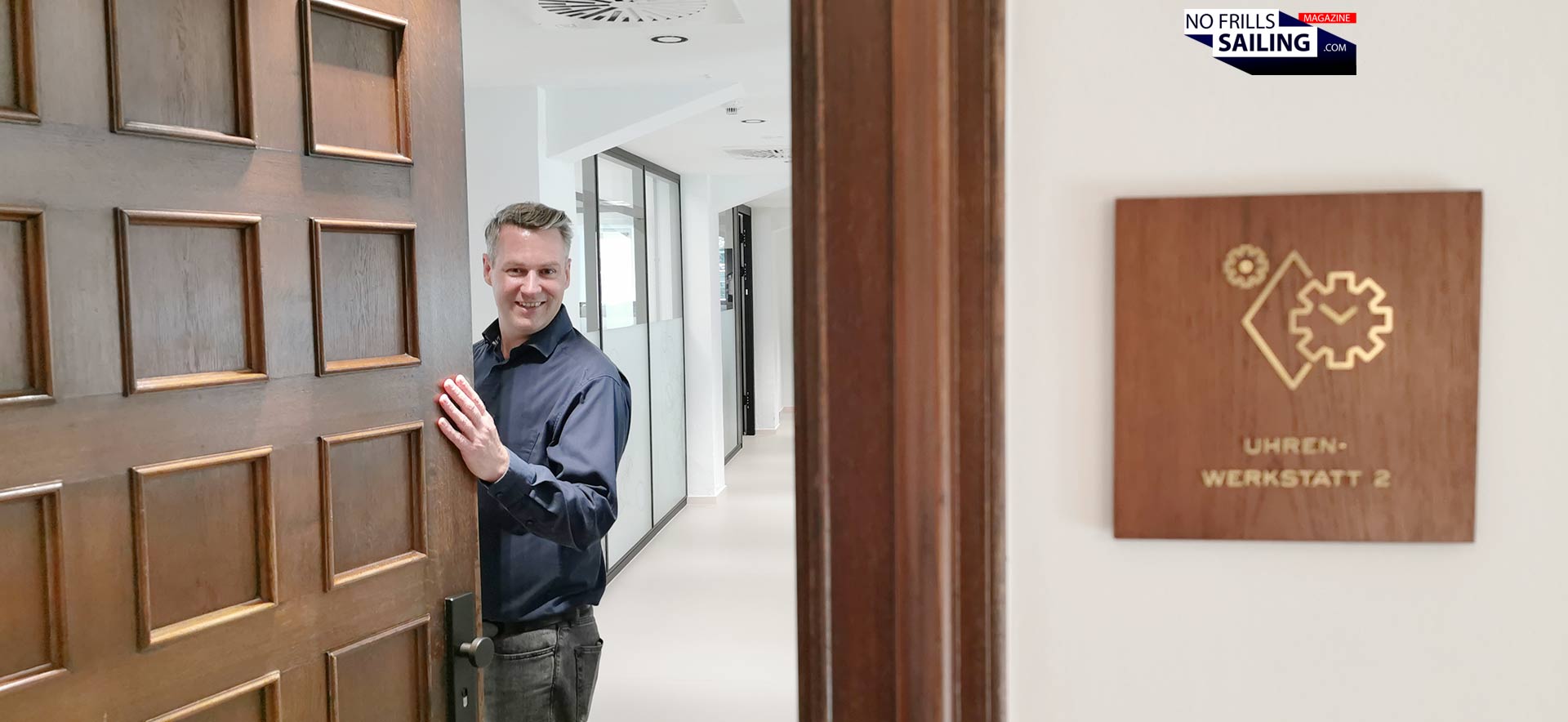
It´s a quiet place. No music, no talks. It´s almost as if you could literally grasp the amount of focus needed to work on those intricate pieces. I enter one of the workshops. I don´t know what I was expecting, but there was dead silence! I ask Julius why I can´t hear any ticking, because this room was literally stuffed with big, big clocks. He smiles: “The louder you can hear a clockwork´s ticking, the less premium it is.” I am puzzled: Really? He nods: It´s a sign for a low quality ship´s clock when you can hear it ticking. Many sailors complain about this enervating “noise” when their clock is mounted to a bulkhead (which may amplify the ticking as well). Unpacking the “Navigator II”-ship´s clock I´ve just bought, I press my ear onto the clockwork: Nothing …
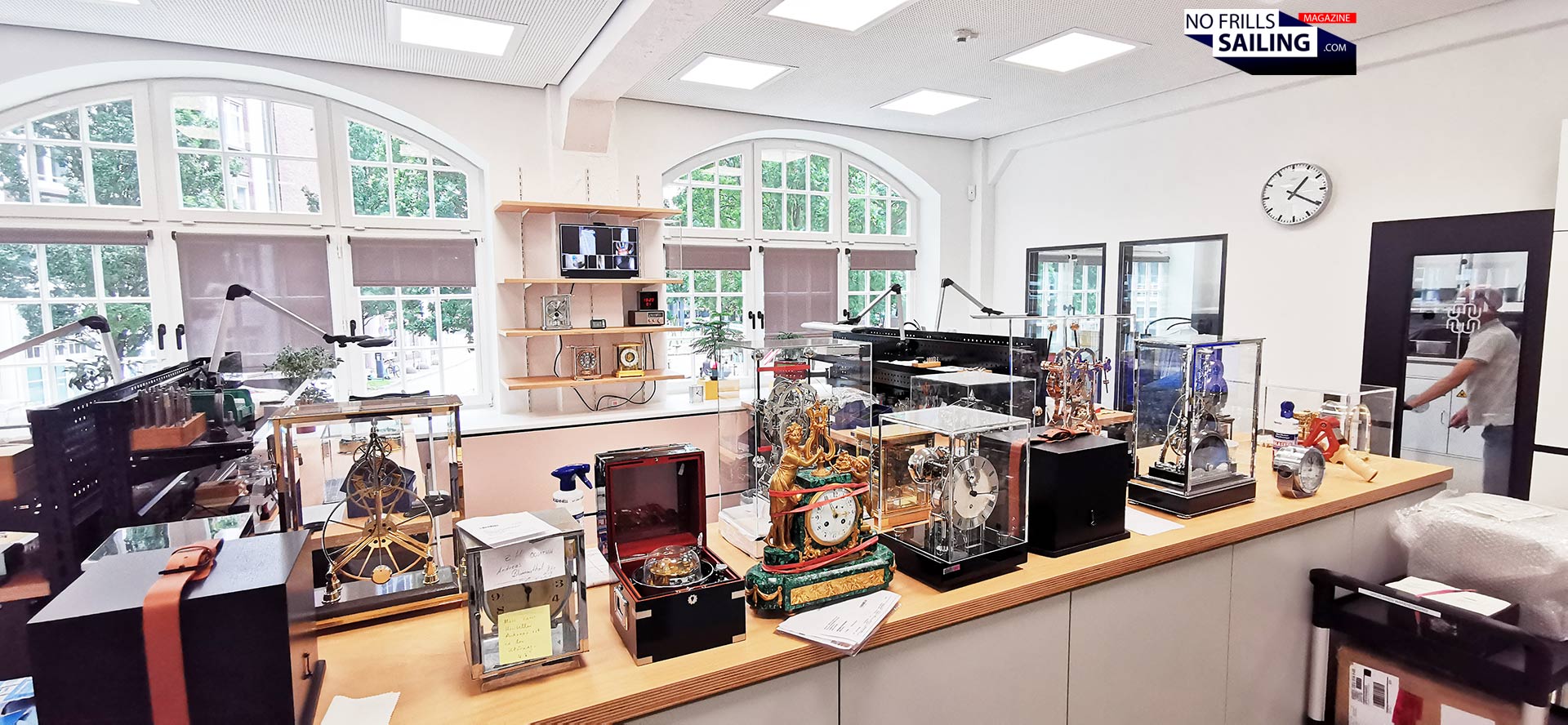
„For ship´s clocks and chronometers this very clockwork is deciding”, Julius explains. There are basically two kinds of clockworks: The classic, intricate and complicated mechanical clockworks, which is so tempting and beautiful. And the modern Quartz-clockworks, operated by electric currents drawn from batteries. Chronometers, the real ones, are always mechanical. These must be wound up every 24 hours – always at the same time of the day and preferably by the very same person. Just in the Golden Days of Seafaring. The clockworks have a maximum runtime of 56 hours, but it is advised to wind up every day. As for the Quartz clockworks, there is no winding up any more, just the occasional check for accuracy and changing of batteries when emptied. In the clockmaker´s workshop Phillip greets us.

He is a professional watchmaker, specialized in chronometers. He tells me that he mastered this beautiful profession in Glashütte, which may be one of the most renowned places to acquire the craftsmanship and knowledge in Germany for sure, maybe even worldwide. Only 6 apprentices are accepted there per year. Phillip made it- and is now one of three master clockmakers qualified to work on these big watches and chronometers. I observe his work for a moment: Steady, calm and in a very controlled manner he picks apart the tiny parts, cog wheels and metal pins. He puts them in front of his desk, one by one, in an extremely accurate way. My inner Monk salutes this man! “Phillip will take apart your instruments, Lars, to show you how these are made”, Julius tells me.
Barometric observations aboard a sailboat: Still valid?
So what about barometers? If you own a yacht and you already have those classic three instruments, a gauge for atmospheric pressure is probably included. To know the atmospheric pressure aboard a ship was one of the key information to gather in order to make accurate predictions. You know how it works: If pressure drops, your boat enters a low-pressure system. Vice-versa, if pressure increases again, you enter a region of high-pressure. Low pressure systems usually translate to “bad weather”, meaning strong winds and precipitation. Same way round, high pressure is often connected with fair weather, higher temperatures. Of course, this is a very rough sense for weather, as you can indeed have “nice” weather in a low pressure system or lots of rain in high pressure circumstances. Anyways, Julius says it is still valid to observe atmospheric pressure in your sailboat.
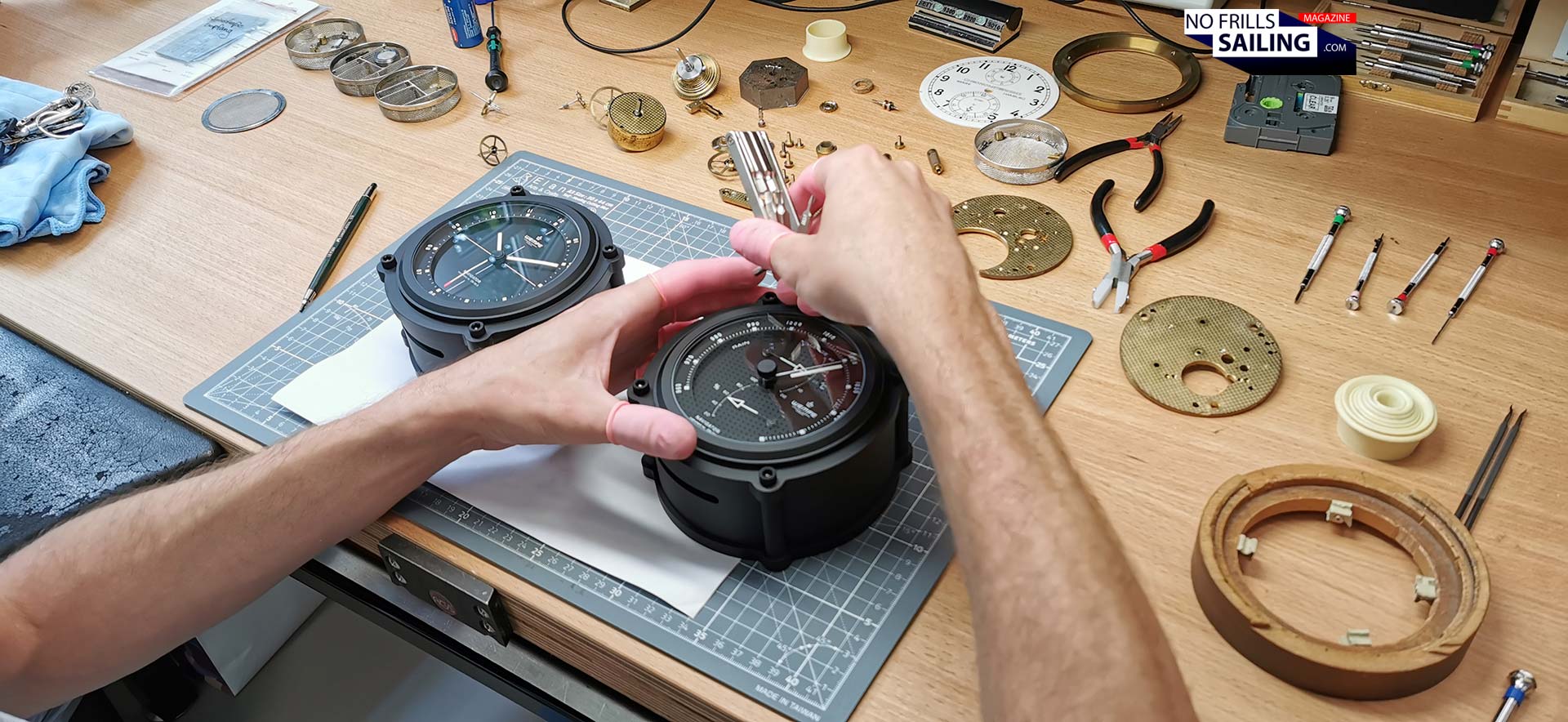
Phillip starts to take apart my “Navigator II” combined instrument. It contains a barometer, a hygrometer and thermometer. We will look at the barometer first, but let´s finish on the theory: The barometer gauges the current atmospheric pressure you are in. You may set the indicator-dial to the current reading. Returning to the barometer after a while, you may then see if the pressure has dropped or risen. “This alone can indicate weather shifts”, Julius explains. As a skilled skipper keeping a regular logbook, you may note the readings in regular, constant intervals. “These readings are much more meaningful now“, Julius says, “because if measured every two hours for example, you may get a really detailed picture of the rate at which atmospheric pressure drops.” A rate of 1 hPa per hour for example is a strong indication for hefty winds approaching and rapid deteriorating weather. As a yacht sailor, you may rigg the boat´s sails for storm and prepare the crew. “It´s these readings combined with your observations of the sea state or cloud formations which gives a pretty accurate forecast about the immediate and imminent weather changes.” So, yes – it´s still valid to have these aboard your sailboat!
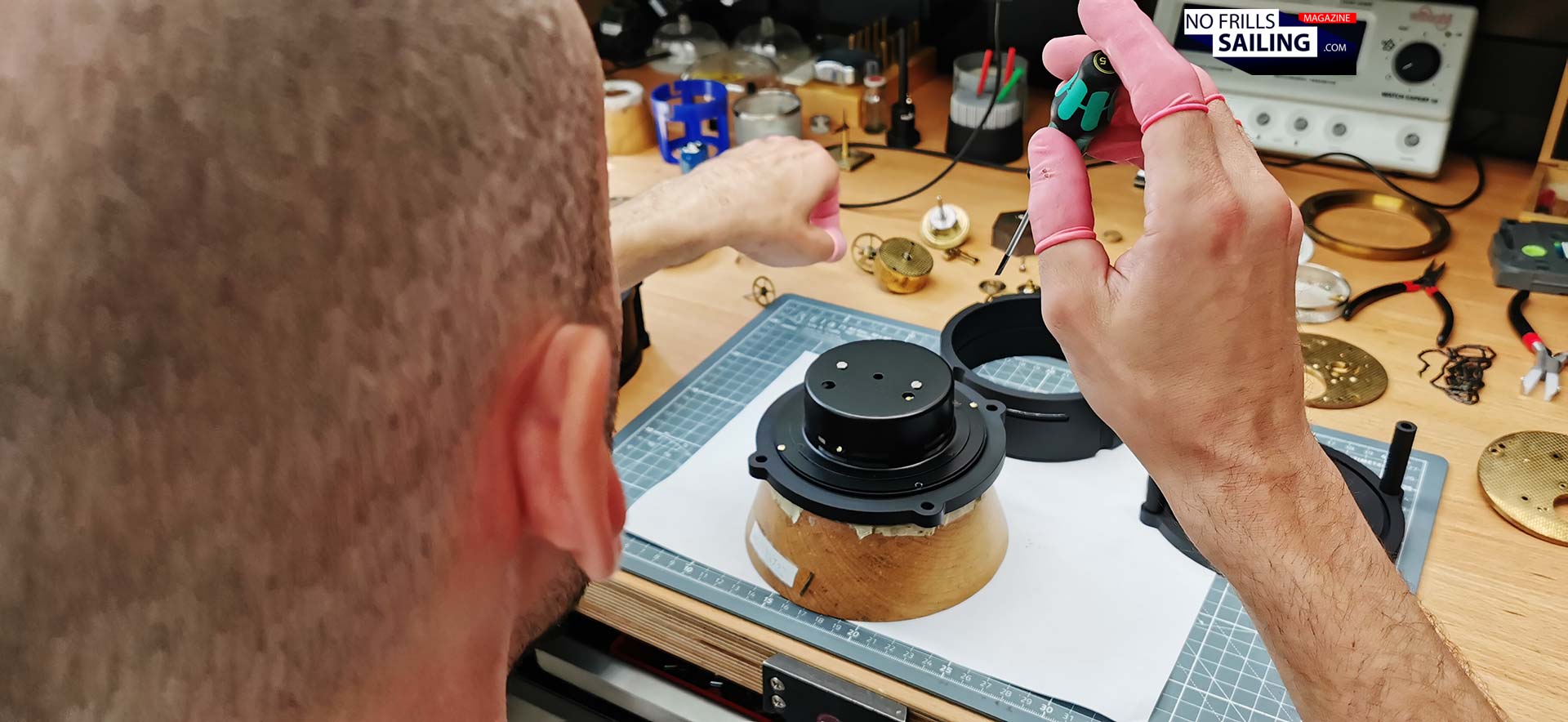
But how does a barometer work? There are analogue and digital methods to gauge atmospheric pressure. Cheap instruments may use piezo-electronic sensors (of which there are also very high-grade sensors, of course). Then there is a method of utilizing quicksilver, but this isn´t all too much used any more. The most common and accurate sensing method is the aneroid-system. An aneroid is a tin container that has been evacuated. There´s literally a vacuum inside. Air pressure in the atmosphere is exerting force onto this container, the aneroid, hence making it expand or shrink. This process is amplified by the shape of the aneroid, in my case, it´s a flat dose. Very tiny and delicate mechanic indicators sense the change and transfer it onto the dial in the front of the instrument. Most aneroid barometers utilize one “dose”, or aneroid. “In your instrument we´ve combined two aneroids to increase accuracy, but moreover, reaction time and sensitivity of the instrument”, Julius explains.
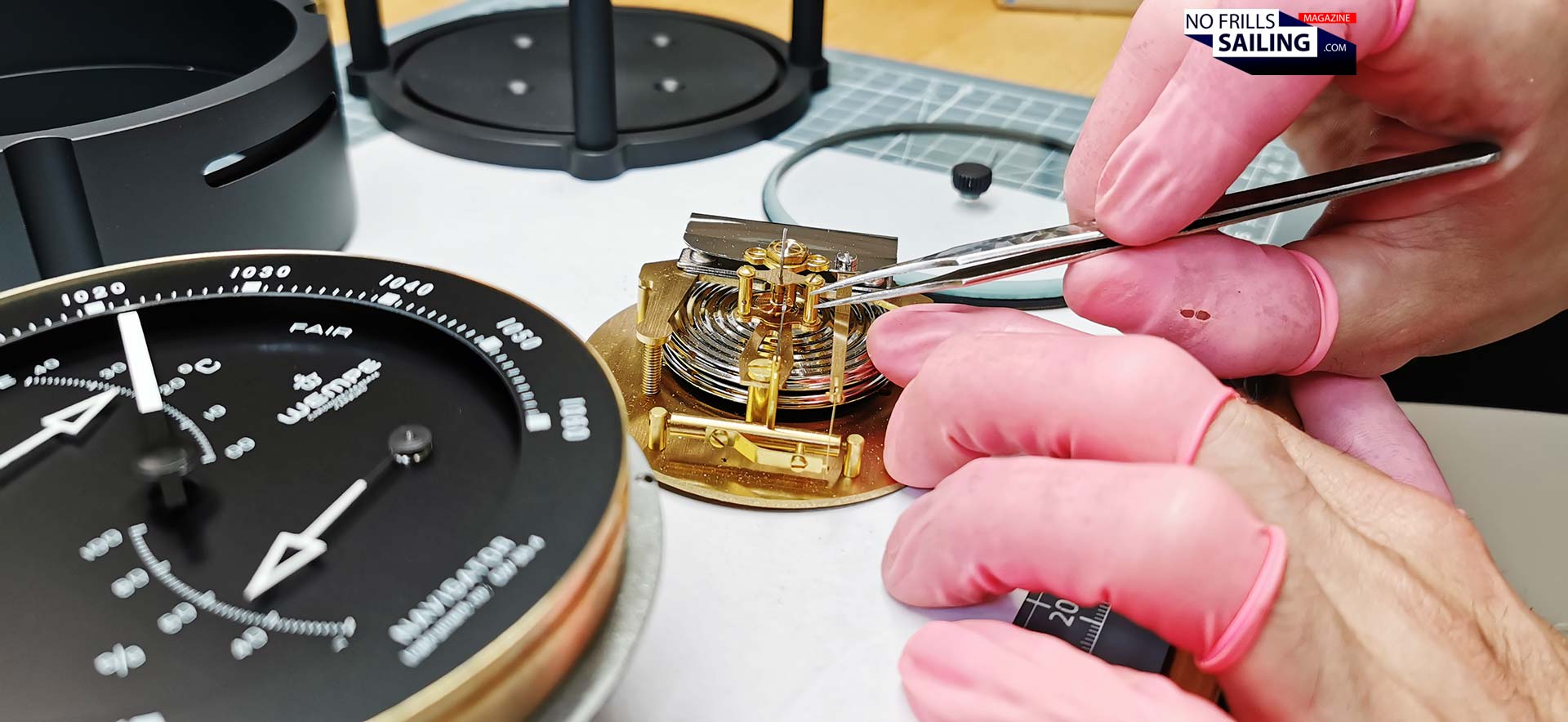
Phillip has now unscrewed the casing, took of the inner protections and lays out the bare gauging device: Again, it´s a filigree masterpiece, like a work of art. Fascinating! He shows me where exactly which part is situated and how these work together. Just like a clockwork and only my mechanical means. Can you spot the dust particles on the barometer in the picture above? Before re-attaching the instrument and putting it back together, Phillip utilizes a high pressure air pump to get rid of the dust. He then checks the reference barometer mounted on the wall of his workshop and calibrates my instrument to fit sea level.
A difficult thing: Measuring humidity aboard a sailing yacht
To show just how fast and accurate these instruments are reacting, Julius puts another one in a plastic bag. “This is a test you can make at home or aboard your yacht to check if your barometer still works …”, he says and blows air into the bag, sealing it with his other hand, just as if he was about to make it pop with a huge blow. “Look at it!”, he says, blowing another time: I can see the indicator go up instantly as air pressure increases inside the bag. It also drops the moment excess air is released: This is how fast these gauges work – in view of something as “slow” as weather systems, that´s incredible! But it gets even more fantastic: Measuring humidity is another level!
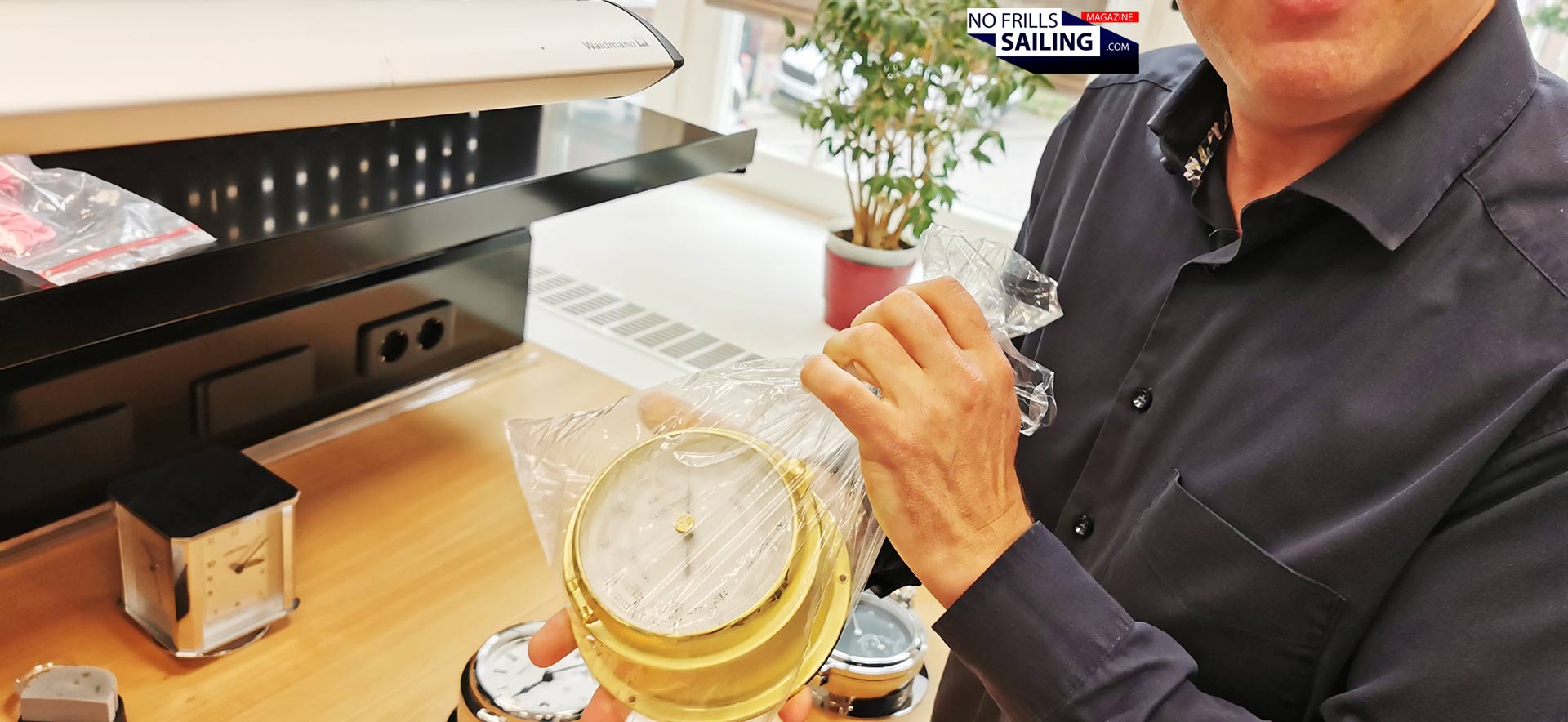
As I said, mine and most barometers are combined instruments. It may be the case that yours is also gauging air humidity. This is an information that is not as important nor anywhere near as accurate for weather forecast. That is mainly because these instrument are mounted inside a boat, hence measuring the humidity inside the salon. Cooking Spaghetti for example will increase humidity manyfold, even the exhaled air of your crew members will significantly alter air humidity of your boat: These readings often say nothing about outside humidity, of course. So why bothering then? Well, Julius explains: “Humidity inside you yacht is of utmost importance when it comes to mould and mildew, for example. During winter storage those readings are a perfect indicator if your boat is nice and dry, or if you should add another dehumidifier.” This is why this gauge is called a “comfort meter” just like the thermometer, that also only displays the temperature inside the boat – it´s about your comfort, not about weather anymore.
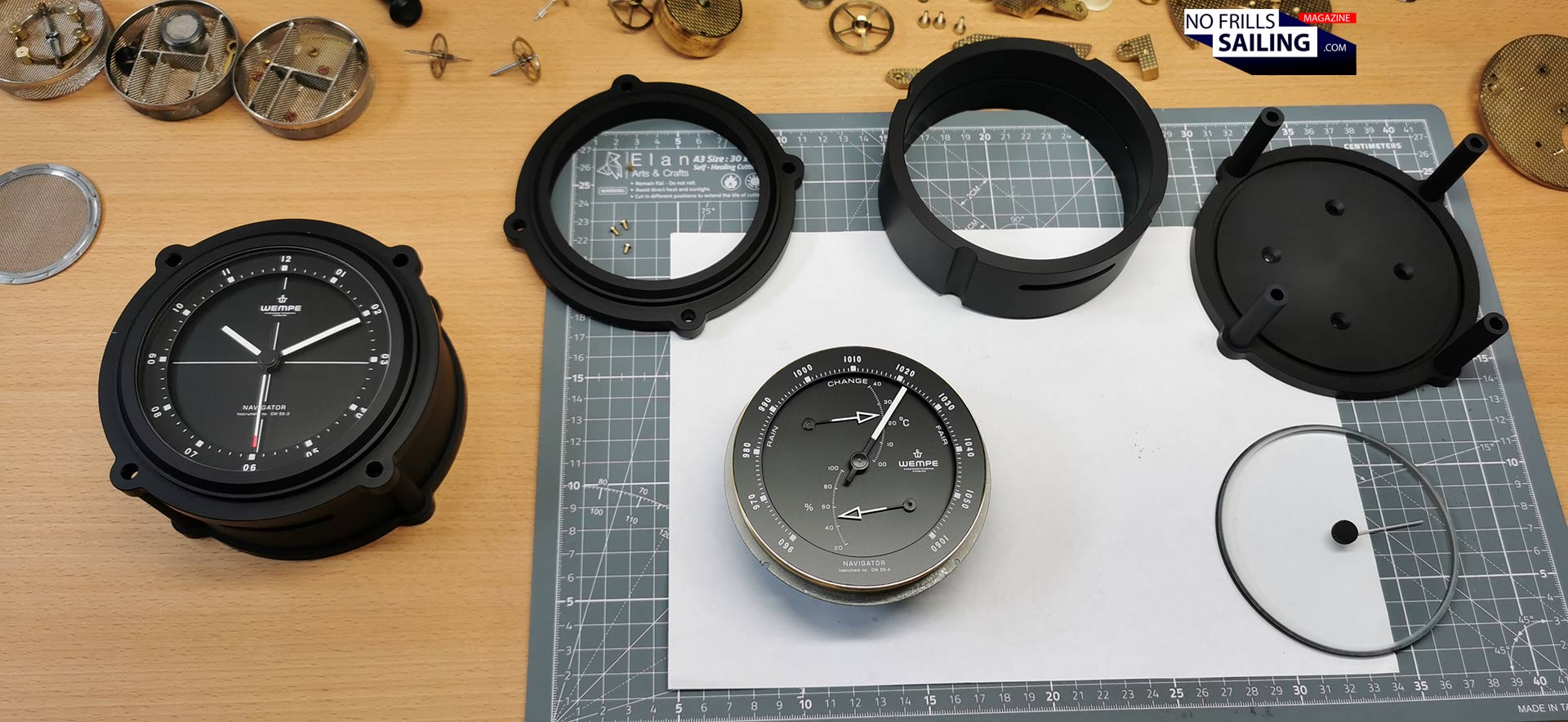
How does a hygrometer work? With hair. Yes, you´ve read right, with hair. At least this was the case up until synthetic filaments have been invented. Julius explains: “Just as your own hair tends to become kind of soaked when wet, for example when you take a shower at home, this effect can be seen not just on your head when your hair style changes to curly, but also within the smallest parts, the individual hairs. Until not so long ago, animal hair (mostly from horses) has been used to gauge changes in humidity. Today – even in your instrument – we utilize synthetic fibers. But the mechanics are the same.” Did you know this? How cool is that?! And yes, my Italian wife tends to get much more volume in her her when we are visiting her home in Sicily or are on vacation in the more humid south. Back in dry Germany, it´s visibly flatter. Turns out, her hairdo is a hygrometer as well …
What´s the best place to mount marine instruments in a sailboat?
As Philipp is putting back together my instruments with utmost care, I am asking Julius where I should put those in my boat. What´s the best location? He says that these precision instruments most of all need a dry place to be mounted. That´s usually the forward or main bulkhead. It´s a great place because they are protected from spray coming down through the main companionway and also from humid steam from the boat´s galley. A protected location near the chart table or nav-station is also acceptable, if protected. “Worst place would be right in the entryway, exposed to saltwater and UV radiation!”, he adds.
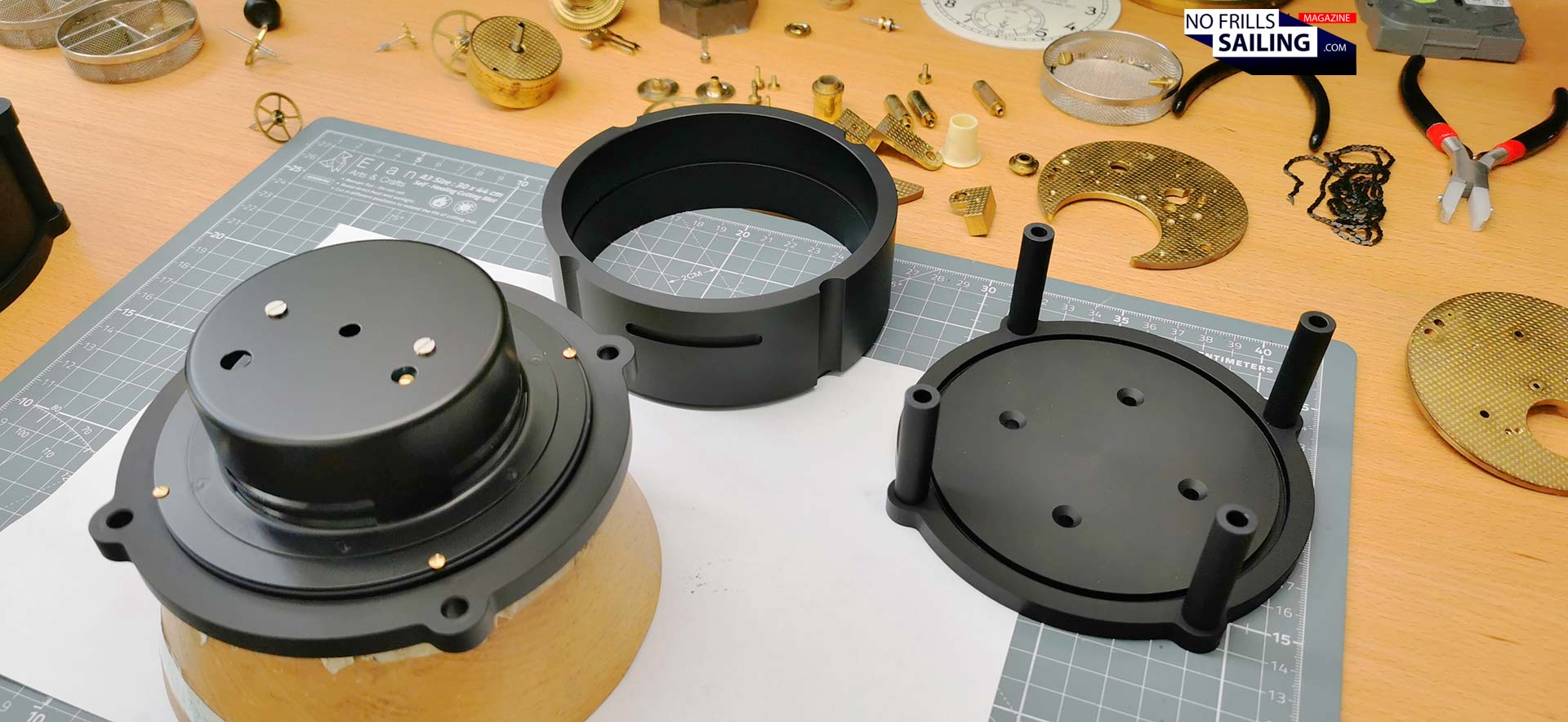
Meanwhile Phillip has put the inner mechanics, the double aneroids and protective casings back into the massive outer casing. It´s a specialty for Wempe marine instruments and their prime products: Both the casings for the stainless steel and the aluminum variants are made from a single solid block. A very precise CNC-machine is milling those complex shapes, resulting in not only a very rugged and durable casing, but also in a very beautiful one. By the way, this fact alone was a major contributor for my buying decision with Wempe.
Advantages of digital weather stations aboard sailing yachts
Of course I had done my research for digital weather stations. I know these from my parent´s home, where multiple external sensors are submitting various sets of data via Bluetooth to a display. This display has all readings at one glance and, depending on the type of tool, can also display barometric graphs or graphs of any sort. No need for manual log keeping. Some even have internet access, including online weather data and corroborating these with your local data. Truly fascinating. But again: That´s a digital. There is no single manufacturer who is responsible for putting together everything: Sensors, displays, motherboards and such are usually third-party components, Made in China. Nobody knows what´s inside. How long will such a tool last, exposed to the ocean´s elements?
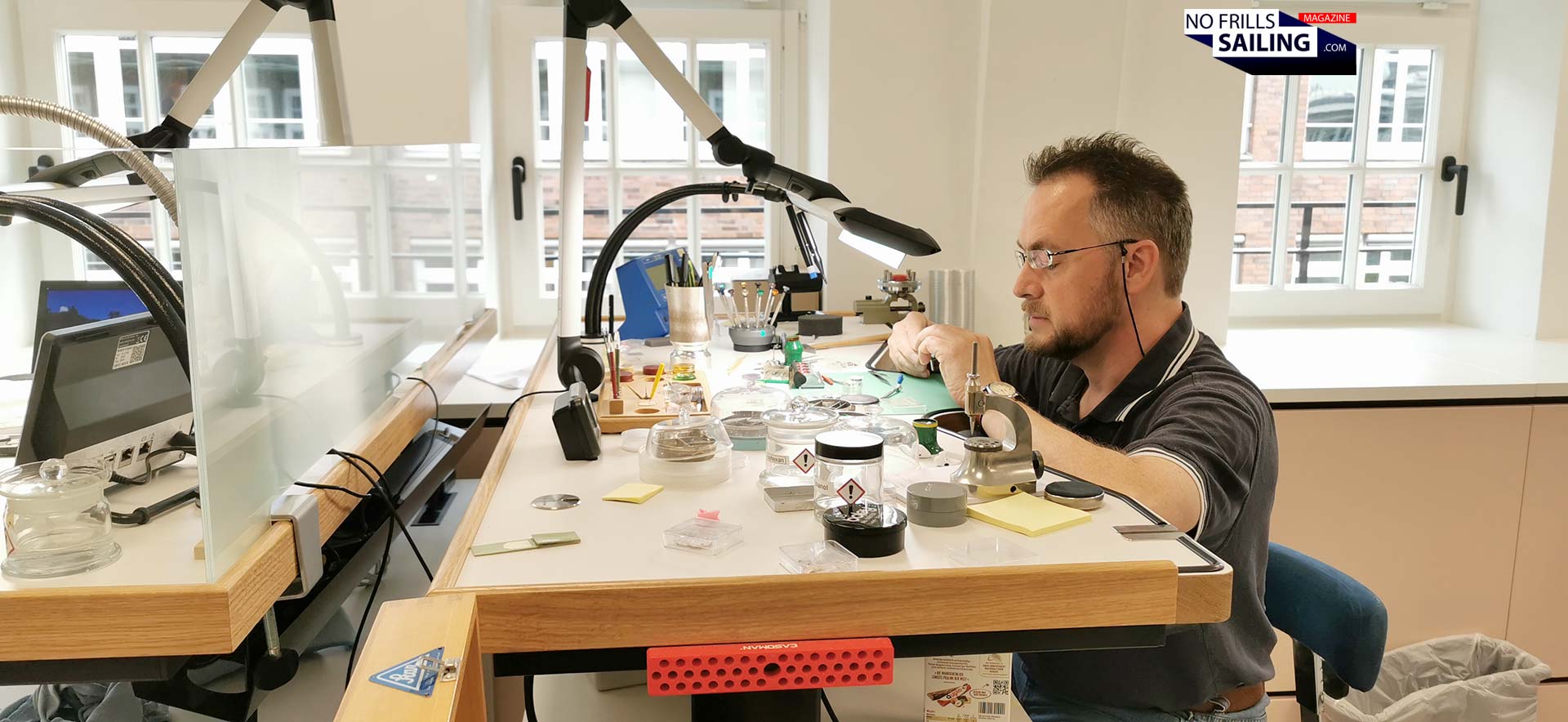
I´m in no way trash-talking “Made in China” here! What I want to emphasize is that the analogue monitoring tools are made by people like Philipp and his colleagues, right here in Hamburg and affiliated production locations in Germany. Except for the high-grade Seiko Quartz clockworks, everything made by Wempe is 100 percent German-made. In the workshop I see instruments older than myself, handed over into the custody of Wempe to be refurbished and re-calibrated – to go on working for another 45 years and more. That´s the difference: This is here to last. And to outlast. It is working completely independently from any digital services, microchips and connectivity. If kept in a good shape (regularly wiped clean, maybe conserved with some Ballistol oil), they can last forever. How long does your latest iPhone last?
Which marine instruments do I go for?
This is all very interesting, you might think now. Doing a quick research in Google reveals that even for analogue marine instruments multiple brands and products are available. If you just look for some stylish decorative element in your home, the low-priced products may be very well suitable. If you look for something to mount in your yacht and take on your sailing trip around the world, go for a high grade product! As a matter of fact – and indeed very, very sad, news are breaking that Barigo has filed for insolvency as of June 2025. This hits hard as this German company was as well a very renowned brand, with almost 100 years of tradition. That said, it leaves Weems & Platz, Plastimo and Wempe the sole big names in the market. Plastimo being the lower price range of the “good” products, Wempe certainly the upper shelf.
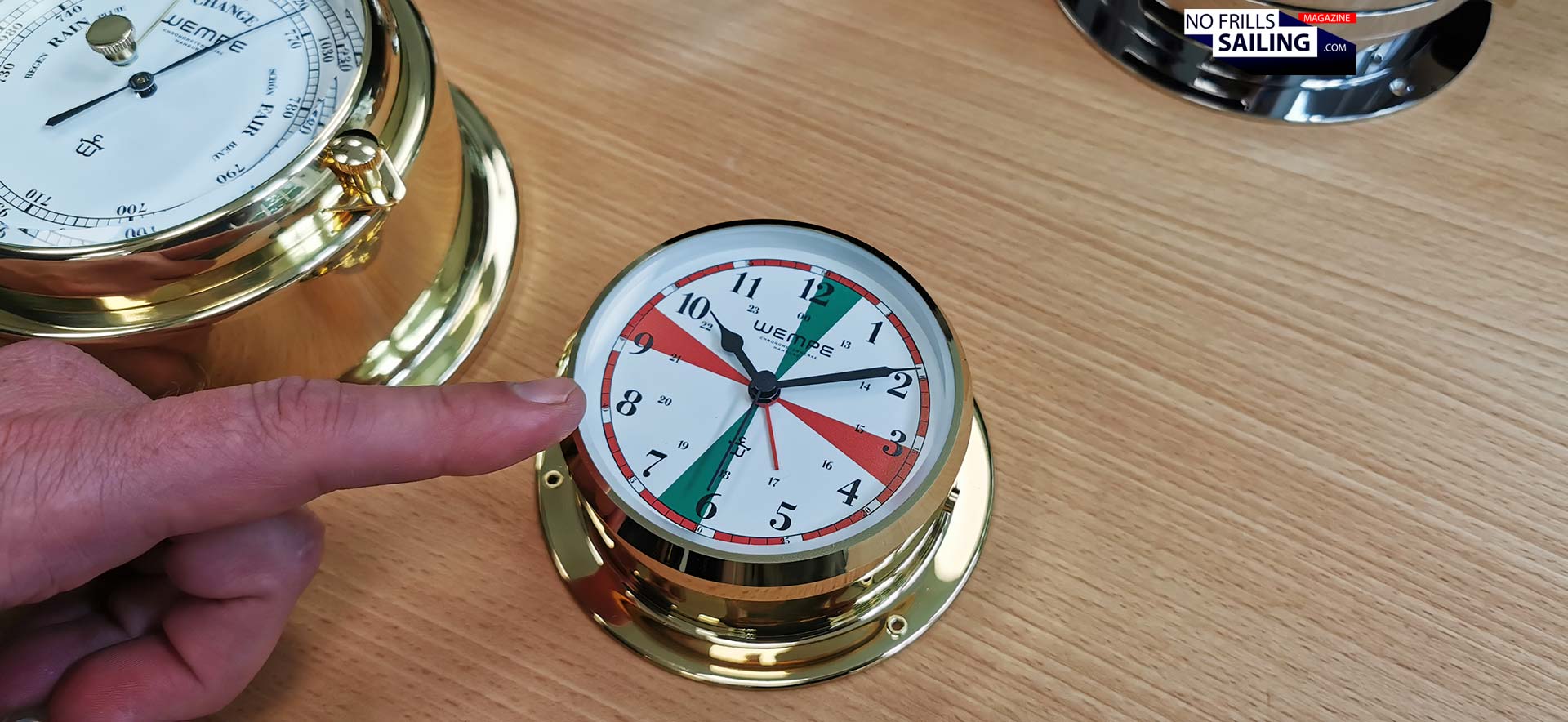
Within Wempe there are different ranges of marine instruments from which to choose. Julius shows the “Skiff”-series with their distinctive design. The red and green markings as well belong to past times when there were specific minutes of radio-silence per hours. “Skiff” is preferred by skippers of regatta or performance boats. Then there is the very, very classical “Bremen”-series – and its counterpart, the reduced and sleek “Pilot”-series. Both are available in chromium-plated design of polished stainless steel casings. If you prefer the classy brazen look, “Bremen” can be PVD-coated to achieve the brass looks.
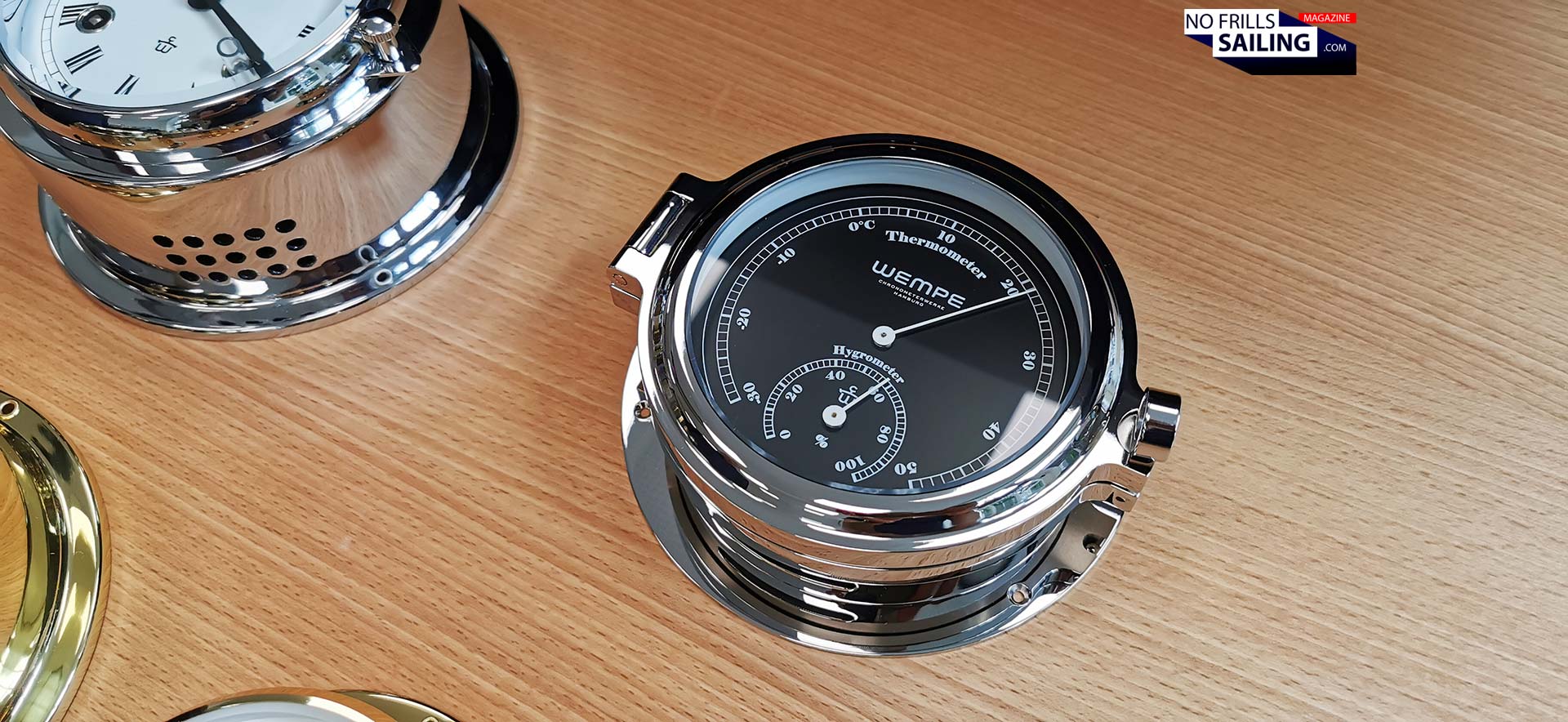
“We acknowledge a shift in trends here”, Julius tells me. “The sale of brass instruments is decreasing. We are more and more selling the polished stainless steel-designs. And the series you went for, our “Navigator II” with black anodized casings is a top-seller as well.” Which brings us to “my” instruments: Reading my blog and the building progress-articles of my Omega 42, you might know that I try to have any metal parts of the boat in black. That goes for the entryway-ladder mount, the taps and sinks in the galley and head and the legs for the saloon´s table. Adding the bling of chrome or brass wouldn´t fit here. Wempe´s “Navigator II” is exactly what I was looking for!
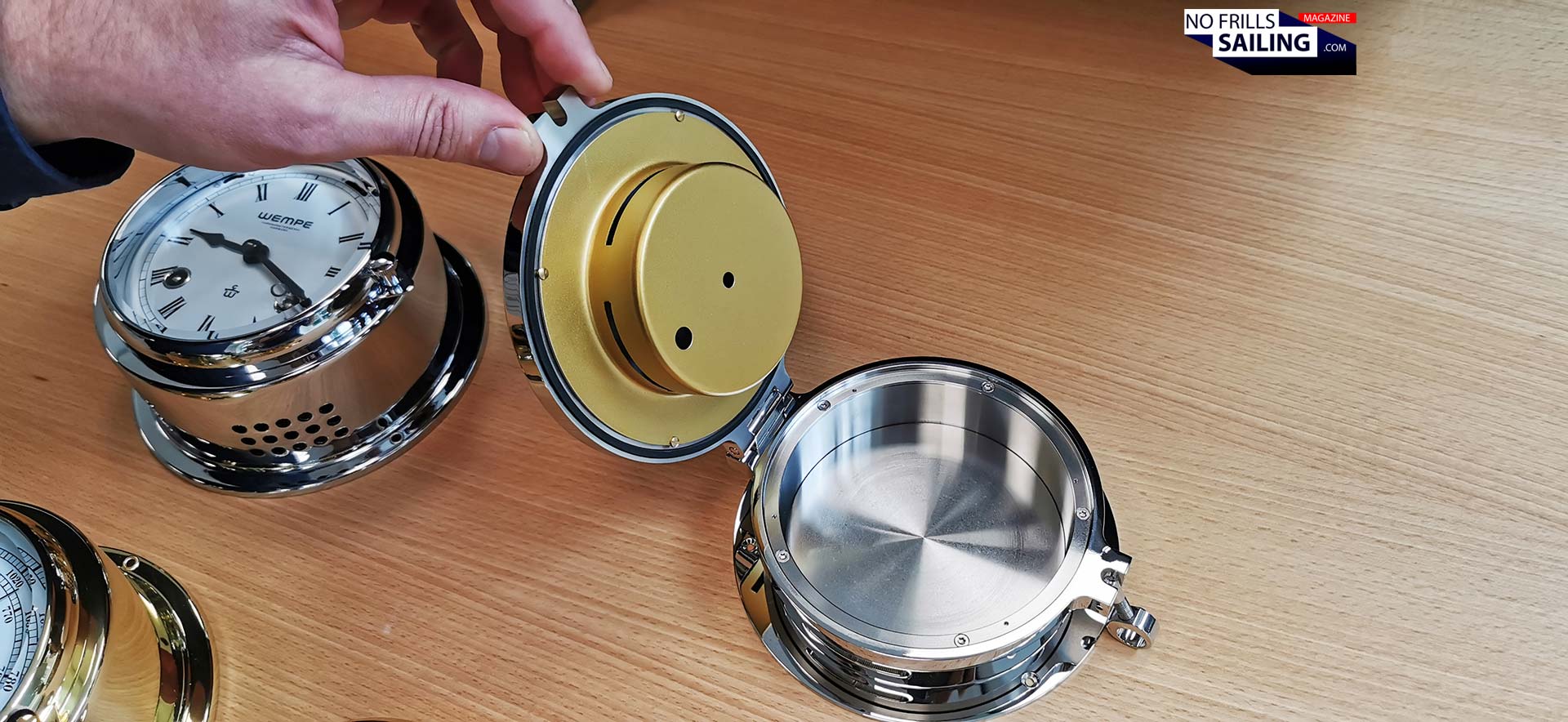
This series marks the upper end of Wempe´s product range, together with the instruments of the “Regatta”-design. “Bremen” is on a, let´s say, middle level, when it comes to pricing. If you seek something more affordable, you may check their “Bremen”, “Pilot” and “Skiff”-series. Either way, modern style meets classic lines, state-of-the-art production methods are combined with high class clockworks. Julius insists that in each Wempe product high-grade clockworks and materials are utilized. The differences in prices do not mean that there are differences in accuracy or durability. “On principle we consider all of our products high grade when it comes to their usability and quality. The main differences are really the way they are made: Filigree of casings, faces, dials or the depth of details.”
It depends on the boat …
In this, it´s a decision that depends on you as a skipper and the style of your yacht, I would say. Julius says that Hallberg-Rassy for example fancied the “Pilot” and “Bremen”-series, whereas Linjett Yachts preferred the “Skipper”-series. There´s a product for every style and every taste. Even mine. I am so happy with the “Navigator II”-products. These things are much bigger than they appear when you see them online. Taking them into my hand, they appear heavy. A quality sign, at least for me.
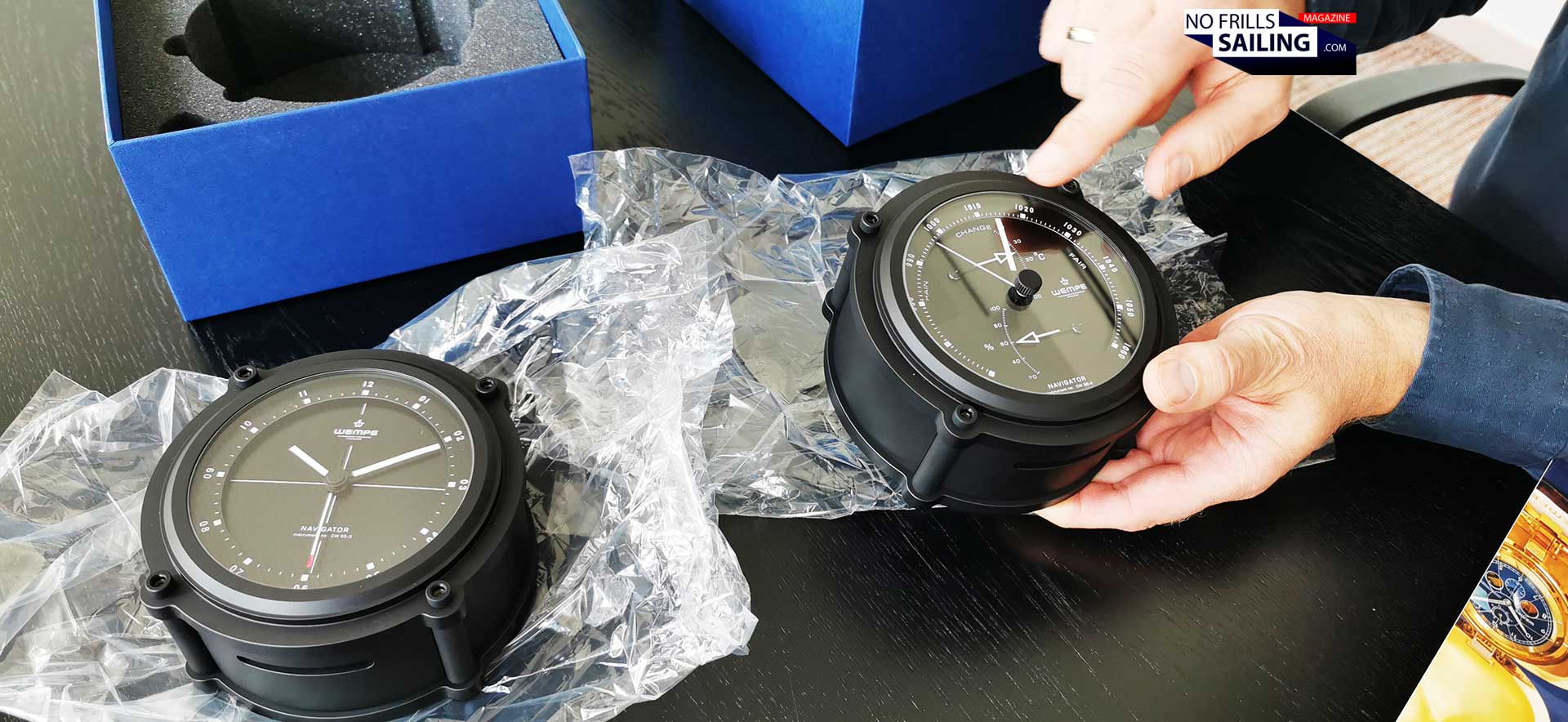
The matt dark black anodized color of the massive aluminum frame reminds me of a fighter plane or some Stealth bomber. It´s a nice mix between a classy analogue instrument and reduced, modern style. I am sure that these two instruments will perfectly integrate into the overall color scheme of ALPHA. And I cannot wait to see them mounted inside the yacht! Yet – I am not quite sure where to put them, to be honest. Maybe I´ll check in a dress rehearsal next time I visit the shipyard.
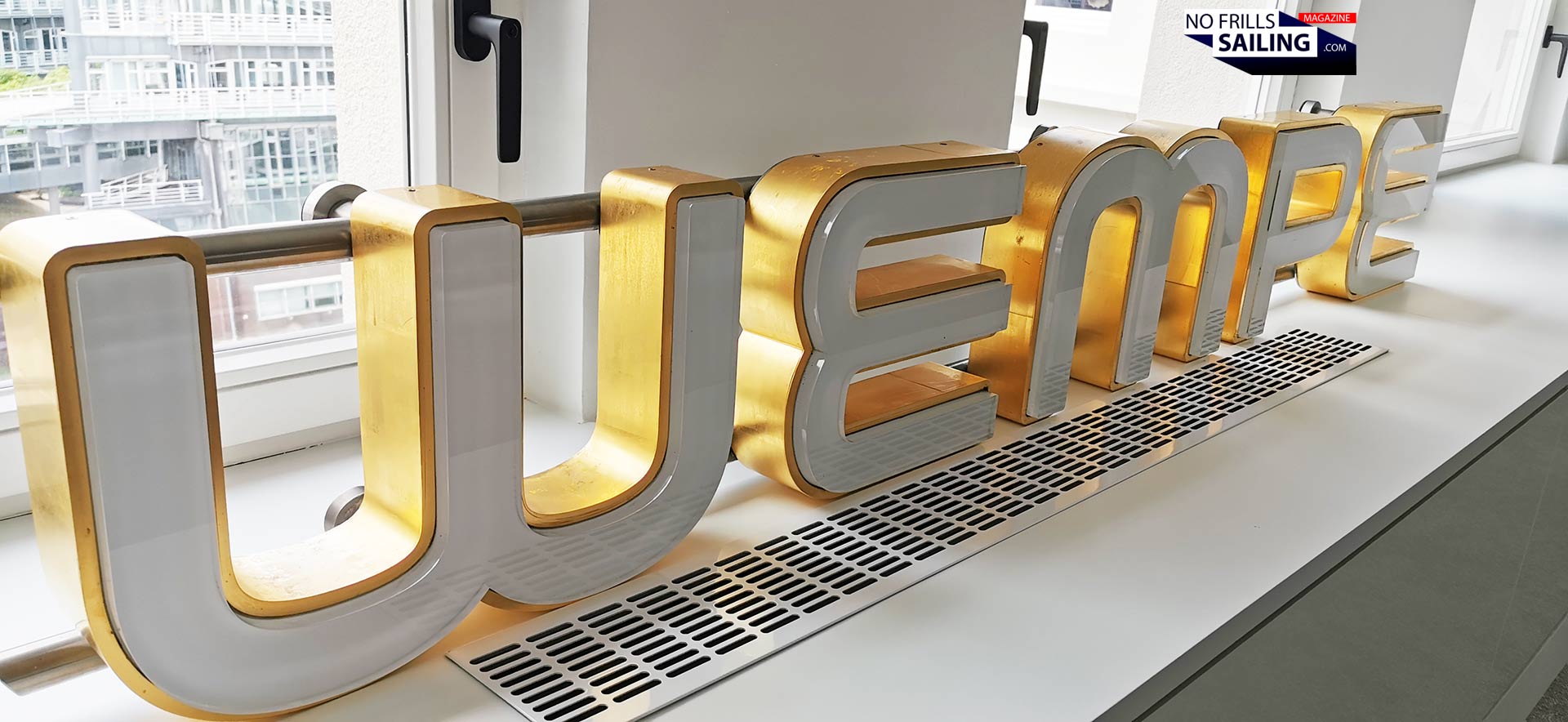
After two exciting and eventful hours in Hamburg it´s time to go. I have drained enough of Julius´ precious time. Putting back the instruments into their nice boxes, I thank him for the elaboration on this topic and the unique insight into this wonderful aspect of sailing and yachting. Wempe, still family owned and family run, is indeed the last active brand spanning this bridge from our present day to these past times of seafaring. Truly historical and a blessing that places like this still exist, where history is not just kept alive for a museum, but is flourishing and prosperous. What a joyful day, thanks Julius!
You might as well check out these related articles about weather and sailing:
My first encounter with Wempe: Are old marine instruments worth a refurbishment?
Reading “Longitude” – a book, that explains how modern seafaring became possible
Turning GRIB-files into valid weather routing with free software
